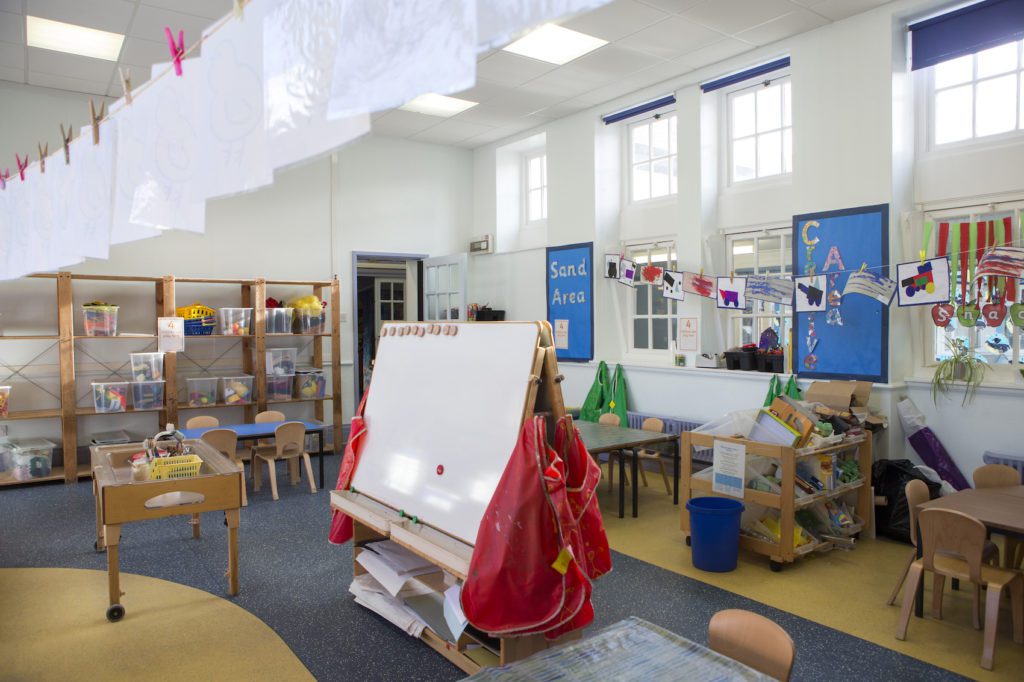Why I Don’t Have “Teacher-Only” Classroom Furniture Anymore

Often called “the silent teacher,” the physical environment is a crucial component of high-quality learning experiences. Room arrangement, material organization, and cozy furnishings all assist educators in sending the Six Positive Messages to children in their class. In fact, the physical environment plays such an important role in the education of young children, that The Creative Curriculum for Preschool, Volume 1: The Foundation, dedicates an entire chapter to the learning environment, and Teaching Strategies has published webinars on this subject as well.
I can still remember decorating my very first classroom after college graduation. I covered the walls from top to bottom with lots of laminations from the local teacher store, arranged all of the desks into groups, decorated my desk with frames and knickknacks, and had the custodian move a horseshoe table to a sunny corner by the window. What more could I possibly need?
Over twenty years later, I realize I should have been asking myself, “What is the purpose of all of this teacher furniture?” When I reflect specifically on my need for both the horseshoe table and my own teacher desk, I find myself wishing I had gotten rid of them sooner! There are many benefits to taking out these specific pieces of teacher-only furniture in your classroom spaces.
Less Teacher-Only Furniture, More “More” in the Classroom
- More organized. Without these two large pieces of furniture, there are fewer places to stack papers, which encouraged me to avoid piles of clutter. Additionally, with fewer flat surfaces that were “mine,” I developed (and maintained) systems for staying organized, from my pen collection to my after-school chocolate stash. I cleaned out a lot of files (and eventually got rid of that, too) and implemented a “Toss After 2 Years” rule. Less really was more! This organization carried over to the children in my classroom as well. Soon, we found all of the items in our classroom more easily accessible and labeled for easy cleanup and storage.
- More space. This benefit is obvious: less furniture automatically increases classroom space for activities. What I didn’t anticipate about removing my desk and large table was how much freedom the increased space opened up for children to create, explore, discover, share, and communicate.
- More intentional. Building a classroom community is important. The Creative Curriculum recommends using the first six weeks to cover topics that will foster relationships with children, families, and teachers, including aspects of room arrangement and how to send messages through the physical environment. By ridding the classroom of this unnecessary furniture, I was able to put into practice what the curriculum was suggesting as I set up my interest areas and shared spaces. Children and families felt like the classroom wasn’t mine, but ours.
- More engagement. With fewer adult places to sit at (and behind!), I found myself on the floor actively participating with the children more. I did more art, built more block towers, read books on cozy beanbags, and drank a lot of make-believe tea. I was able to more readily engage in play throughout the day! Another benefit? Because I was engaged in more play experiences, my GOLD documentation was easier than ever to collect.
Classroom spaces are as different as the teachers and children that inhabit them. Your classroom may still benefit from a few pieces of teacher-only furniture, but be intentional about what you bring into the classroom and how you will use it: reflect on the purpose of teacher-only furniture and the potential costs and benefits of removing it. Remembering that your physical environment influences all aspects of the school experience will ensure that the time children spend in your classroom has the biggest impact possible.

Create a Positive Classroom Community
In our Six Positive Messages to Guide a Year of Teaching and Learning eBook, you’ll discover simple yet powerful messages you can send throughout the year to foster relationships and encourage children to see themselves as empowered participants in a community of learners.
 About the Author: Kristen O’Quinn
About the Author: Kristen O’Quinn
Kristen is the Early Learning Instructional Facilitator for Keller ISD in Texas. She coaches teachers, provides professional development, and implements curriculum changes. Her entire career has been in a variety of early childhood settings.